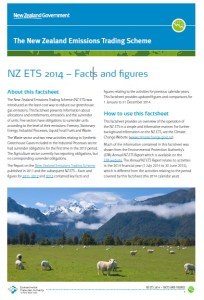The latest data from the New Zealand’s Emissions Trading Scheme, now in its eighth year of operation, is now out from the Environmental Protection Authority (EPA).
 According to the report, NZ ETS 2014 – Facts and figures, nearly all of the emission units handed in by companies in the scheme were purchased from offshore projects — so-called ‘hot-air’ credits.
According to the report, NZ ETS 2014 – Facts and figures, nearly all of the emission units handed in by companies in the scheme were purchased from offshore projects — so-called ‘hot-air’ credits.
Five sectors are currently included in the emissions trading scheme: forestry, ‘stationary energy‘, industrial processes, liquid fossil fuels and waste. The agricultural sector has reporting obligations, but is not currently required to participate in trading.
The SMC collected the following expert commentary. Feel free to use these quotes in your reporting. If you would like to speak to a New Zealand expert, please contact the SMC (04 499 5476; smc@sciencemediacentre.co.nz).
Prof Euan Mason, School of Forestry, University of Canterbury, comments:
“New Zealand’s climate change policy failure is the main feature of the 2014 report on New Zealand’s emissions trading scheme (ETS).
“More than 95% of surrendered credits were imports, and the cost to emitters was approximately 10 cents per imported ‘hot air’ credit during most of 2014, compared to an average of approximately $4 for New Zealand Units (NZUs), our domestic carbon credits, during that year.
“In addition, during 2014 taxpayers gave 4.4 million NZUs to ‘trade exposed’ industries, representing a windfall for them of approximately $17 million, which is their allocation multiplied by the difference in price between domestic and imported credits; we essentially paid them to pollute. Given the low cost of imported ERUs, RMUs and CERs and the fact that we paid people to pollute, it is unsurprising that New Zealand now lags almost all of the rest of the world in its climate change response.
“Since imported credits were outlawed earlier this year our NZU price has gradually risen to around $7/credit. This price is much too low to encourage the level of tree planting we need in order to avoid a blowout in our carbon accounts during the 2020s as trees planted during the 1990s are harvested.
“Figure 3 shows that only 42% of post-1989 forests are registered in the ETS. Figure 4 shows the dramatic reduction in new forest planting and the resumption of deforestation that coincided with imports of cheap ‘hot air’ credits that began in earnest towards the end of 2011.
“New Zealand’s creative accounting with ‘hot air’ credits has done two things:
- Our government has used the ETS to harvest a large volume of ‘hot air’ credits that will likely be used to claim that we ‘met’ our national commitment to reduce net emissions to 5% below 1990 gross levels by 2020.
- Many ETS participants have hoarded approximately 153 million NZUs in the ETS registry by storing grandfathered allocations of NZUs and then surrendering cheap ‘hot air’ credits to account for their pollution instead. This will enable them to meet their ETS commitments for many years to come.
“Our ETS can be made to work if we:
- Stop grandfathering credits
- Have no random gifting of NZUs from Government to industry
- Apply the ETS equally to all sectors
- Allow trading only between sequesterers and emitters
- If you overpollute you pay someone else to clean up
- Manage our domestic credits as a currency rather than as a commodity
- Set reduction targets each year
- Require surrenders only for “over target” greenhouse gas emissions
- Set annual emission reduction targets that stabilise the NZU price
- Plan to gradually reduce our NZU price as the world solves the climate change problem”
Prof Ralph Sims, Director, Centre for Energy Research, Massey University, comments:
“The EPA report serves to confirm carbon emitted from deforestation will soon exceed forest C sinks from new plantings. (Figure 4 in Facts and Figures shows around 10,000 ha per year deforested in past 3 years and around 7000 ha new plantings in 2011 but hardly any since).
“Hence the forest industry will soon become an emitter as the CO2 removals from the atmosphere were lower again last year (~14.3 Mt CO2) compared with 19.5Mt CO2 in 2013 and 24.2Mt CO2 in 2012.
“This means the CO2 absorbed by our plantation forests will soon not be able to partly offset the CO2 emitted from burning fossil fuels and both our gross (total) and net (total minus removals) emissions will rapidly rise after around 2020.
“What the EPA reports don’t tell us is, other than for the forest sector, is which sectors, such as transport, have actually reduced their emissions in the past few years as a result of the ETS and by how much.
“Given that NZ’s CO2 gross emissions for transport continue to rise rapidly, I suspect there has been little if any impact at all.”